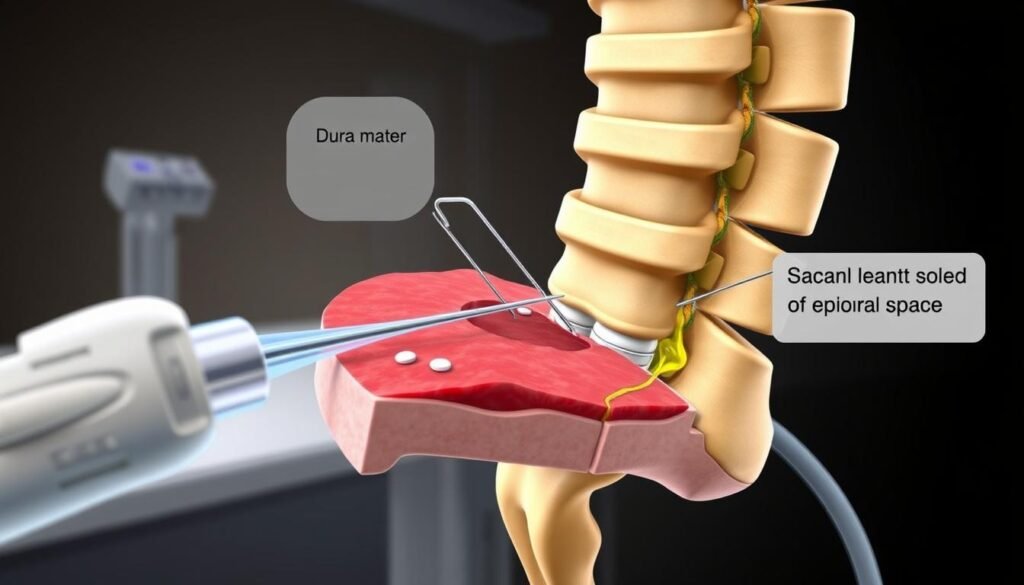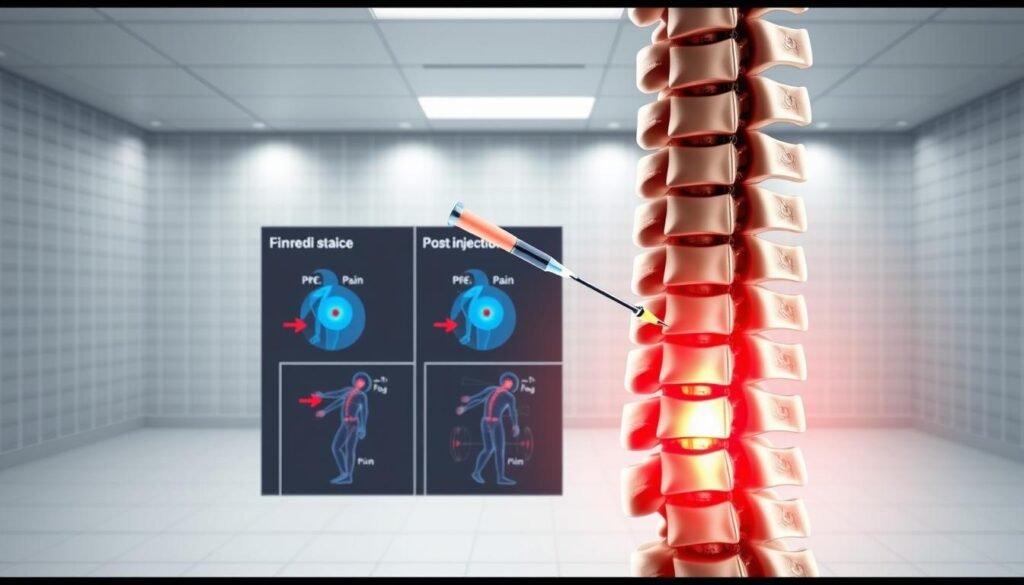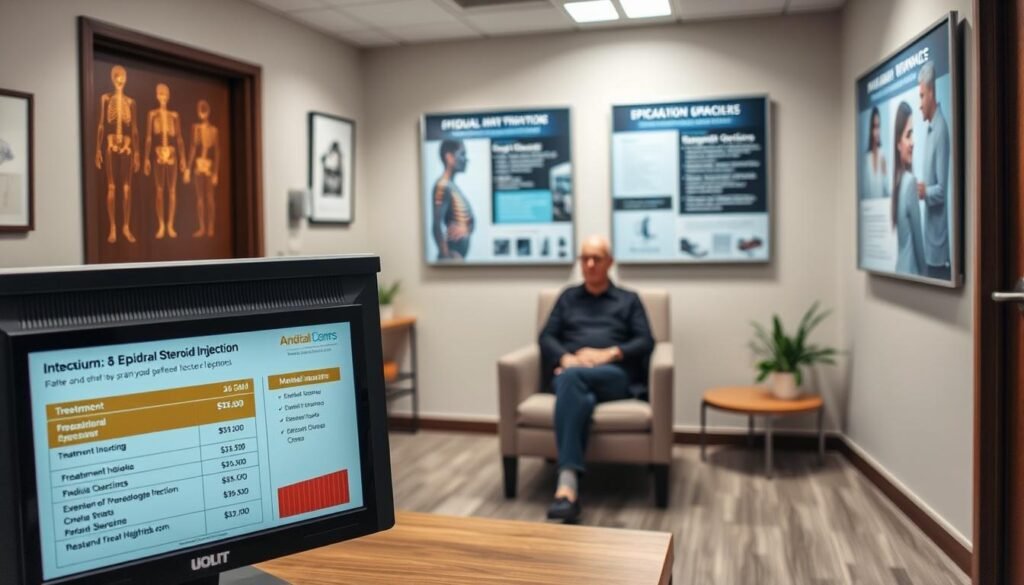Lower back pain is a debilitating condition that affects millions of people worldwide, often resulting from nerve irritation or inflammation. For those suffering from chronic back pain, finding an effective treatment can be a long and arduous process.
Caudal epidural steroid injections have emerged as a viable treatment option, offering significant relief for many patients. This procedure involves injecting steroids into the epidural space surrounding the spinal nerves to reduce inflammation and alleviate pain.
As we explore the effectiveness of epidural steroid injections in treating lower back pain, this article will guide you through what to expect from the procedure, its benefits, and potential outcomes, helping you make an informed decision about your treatment options.
Key Takeaways
- Caudal epidural steroid injections are a minimally invasive treatment for chronic lower back pain.
- The procedure involves injecting steroids into the epidural space to reduce inflammation.
- Many patients experience significant pain relief within a few days.
- The treatment is typically done on an outpatient basis with minimal downtime.
- Understanding the effectiveness and potential side effects is crucial for patients considering this treatment.
Understanding Caudal Epidural Steroid Injections
For patients suffering from lower back pain, caudal epidural steroid injections offer a potentially effective relief method. This procedure involves injecting steroid injections into the epidural space to reduce inflammation and alleviate pain.
Definition and Purpose
A caudal epidural steroid injection is a type of epidural steroid injection that targets the lower lumbar and sacral nerve roots. The procedure involves inserting a needle through the sacral hiatus, making it a relatively straightforward technique with a lower risk of complications.
How It Differs from Other Epidural Injections
Caudal epidural injections differ from other types of epidural injections, such as interlaminar and transforaminal injections, in terms of the entry point and coverage area. The key differences include:
- The caudal approach enters through the sacral hiatus, reducing the risk of dural puncture.
- Caudal injections provide diffuse coverage of the lower lumbar and sacral nerve roots, whereas transforaminal injections target specific nerve roots.
- The caudal approach is often preferred for patients with extensive lower back pathology or previous lumbar surgery.
Common Conditions Treated with Caudal Epidural Steroid Injections
Several common spinal issues can be effectively treated with caudal epidural steroid injections. These injections are particularly useful for managing pain caused by inflammation and irritation of the nerve roots in the lower back.
Lower Back Pain
Lower back pain is a prevalent condition that can significantly impact a person’s quality of life. Caudal epidural steroid injections can provide relief by reducing inflammation around the affected nerve roots, thereby alleviating pain caused by various spinal conditions.
Sciatica and Radiculopathy
Sciatica and radiculopathy involve pain that radiates along the path of the sciatic nerve, often caused by irritation or compression of the nerve roots. The steroid medication in caudal epidural injections helps reduce inflammation, providing relief from this type of pain.
Lumbar Disc Herniation
Lumbar disc herniation occurs when the inner material of a spinal disc protrudes through the outer layer, potentially compressing nearby nerve roots. Studies have shown that epidural steroid injections can be effective in managing the pain associated with this condition, potentially avoiding the need for surgical intervention.
| Condition | Treatment Benefit | Primary Symptom Relief |
|---|---|---|
| Lower Back Pain | Reduces inflammation | Pain alleviation |
| Sciatica and Radiculopathy | Decreases nerve irritation | Radiating pain relief |
| Lumbar Disc Herniation | Reduces nerve compression | Alleviates pain and discomfort |
How Caudal Epidural Steroid Injections Work
Understanding how caudal epidural steroid injections work is crucial for patients considering this treatment option. These injections are designed to provide relief from pain and inflammation associated with various spinal conditions.
Mechanism of Action
The primary mechanism through which caudal epidural steroid injections exert their effect is by reducing inflammation around the nerve roots. Steroids achieve this by blocking pro-inflammatory mediators such as phospholipase A2 and histamine.
Anti-inflammatory Effects
The anti-inflammatory effects of steroid injections are pivotal in providing pain relief. By inhibiting the inflammatory cascade, these injections decrease swelling and improve blood flow to the affected neural tissues, thereby facilitating healing.
| Effect | Description |
|---|---|
| Reduced Inflammation | Blocking pro-inflammatory mediators |
| Improved Blood Flow | Enhancing circulation to neural tissues |
| Pain Relief | Decreasing swelling around nerve roots |

Preparing for Your Caudal Epidural Steroid Injection
To ensure a smooth and effective treatment, patients must prepare adequately for their caudal epidural steroid injection. This involves understanding and following specific guidelines provided by your healthcare provider.
Pre-procedure Instructions
Before the procedure, certain precautions and preparations are necessary. Epidural steroid injections should not be administered to pregnant patients due to fluoroscopy exposure, or to those with bleeding issues, local or systemic infections, congestive heart failure, or diabetes mellitus without proper management.
It’s crucial to follow the pre-procedure instructions carefully to minimize risks and ensure the procedure’s success.
Medication Considerations
Certain medications may need adjustment or temporary discontinuation before receiving a caudal epidural steroid injection. Blood-thinning medications, such as aspirin, warfarin, and clopidogrel, require special management in consultation with your prescribing physician.
| Medication Type | Action Required |
|---|---|
| Blood-thinning medications | Consult with prescribing physician for management |
| Corticosteroid medications | Inform doctor to adjust epidural steroid dosing |
| Diabetes medications | Be prepared for potential adjustments due to steroid effects |
The Caudal Epidural Steroid Injection Procedure
Understanding the procedure for caudal epidural steroid injections can help patients feel more prepared for their treatment. The process involves several steps that ensure the safe and effective delivery of the steroid injection.
Positioning and Setup
The procedure begins with positioning the patient in a prone position, typically on a fluoroscopy table. The patient’s lower back is cleaned and prepped with an antiseptic solution to minimize the risk of infection. Local anesthesia is used to numb the area where the injection will be administered.
Needle Placement and Fluoroscopic Guidance
Using fluoroscopic guidance, a physician carefully inserts a needle into the caudal epidural space. This imaging technology allows for precise placement of the needle, ensuring that the medication is delivered to the correct location. “Fluoroscopic guidance is crucial for the accurate placement of the needle,” as it helps avoid complications and ensures the effectiveness of the steroid injections.
Medication Administration
Once the needle is correctly positioned, a mixture of corticosteroid and local anesthetic is slowly injected into the epidural space. The volume of the medication can range from 5-20 ml, depending on the condition being treated. The steroid component provides long-term anti-inflammatory effects, while the local anesthetic offers immediate pain relief. The entire process typically takes only a few minutes, although patients may experience some pressure or mild discomfort during the injection.
What to Expect During the Procedure
During a caudal epidural steroid injection, several factors contribute to the overall experience. The procedure is typically performed in a controlled environment where your vital signs are closely monitored.
Duration and Discomfort Levels
The duration of the procedure is generally short, lasting around 15 to 30 minutes. While some patients may experience minor discomfort during the injection, the use of local anesthesia helps to minimize pain. The level of discomfort can vary, but most patients find it tolerable.
Monitoring During the Procedure
Throughout the epidural steroid injection procedure, your vital signs, including blood pressure, heart rate, and oxygen levels, are continuously monitored. A medical team, consisting of the physician and at least one assistant or nurse, is present throughout. The physician will communicate with you during critical moments, such as needle placement and medication administration, and may ask you to report any unusual sensations like sharp pain, numbness, or tingling.
| Monitoring Aspect | Description |
|---|---|
| Vital Signs | Blood pressure, heart rate, and oxygen levels are continuously monitored. |
| Medical Team | A physician and at least one assistant or nurse are present throughout the procedure. |
| Patient Communication | The physician communicates during critical moments and asks for feedback on unusual sensations. |
Immediate Post-Procedure Experience
The immediate post-procedure experience following a caudal epidural steroid injection is a critical period for assessing initial recovery and potential side effects. During this time, patients are closely monitored for any adverse reactions to the epidural steroid injections.
Recovery Room Monitoring
After the procedure, patients are taken to a recovery room where medical staff monitor their vital signs and assess their overall condition. This monitoring period allows healthcare providers to identify and address any immediate complications or concerns related to pain or other side effects.
Same-Day Discharge Process
Since CESIs are outpatient procedures, patients are typically discharged on the same day. Before leaving, patients receive detailed instructions on post-procedure care, including activity restrictions, potential side effects to watch for, and follow-up appointment scheduling. It’s essential to have a responsible adult drive you home after the treatment, as a safety precaution. Patients are also provided with written guidance on managing medications and resuming normal activities.
| Post-Procedure Instructions | Description |
|---|---|
| Activity Restrictions | Avoid heavy lifting, bending, or strenuous activities for a specified period. |
| Medication Management | Follow the provided guidance on managing pain and other medications. |
| Follow-up Care | Schedule a follow-up appointment to assess the effectiveness of the treatment. |
Recovery Timeline After Caudal Epidural Steroid Injection
After receiving a caudal epidural steroid injection, patients often wonder what to expect during their recovery. The recovery timeline can vary, but understanding the general process can help manage expectations.
First 24 Hours
In the first 24 hours, patients may experience varying levels of pain relief. The steroid administered during the procedure takes time to become effective. It’s essential to keep a pain journal to track your response to the injection, which will help your healthcare provider assess its effectiveness.
First Week and Beyond
As the steroid takes effect over the next 2-7 days, most patients can gradually return to normal activities within the first week. However, your doctor may recommend avoiding high-impact exercises. Follow-up appointments typically occur 2-4 weeks after the procedure to evaluate progress.
| Time Frame | Expected Outcome |
|---|---|
| 0-24 hours | Varying levels of pain relief; steroid starts taking effect |
| 2-7 days | Full therapeutic effect of steroid; anti-inflammatory properties peak |
| 1 week | Gradual return to normal activities |
| 2-4 weeks | Follow-up appointment to assess progress |
Our study showed that 85% of patients experienced significant pain alleviation after three months, and 62% experienced moderate improvement after a year following epidural steroid injections. Managing expectations and understanding the time it takes for the steroid to be effective are crucial for a successful recovery.
Effectiveness of Caudal Epidural Steroid Injections
Caudal epidural steroid injections are a widely used treatment for several spinal disorders, with varying degrees of success. Understanding their effectiveness is crucial for both patients and healthcare providers.
Short-term Pain Relief
Caudal epidural steroid injections often provide significant short-term pain relief. Studies have shown that a substantial number of patients experience improvement in their symptoms shortly after the procedure.
Long-term Outcomes
Long-term outcomes vary, with some patients experiencing sustained relief, while others may require additional treatments. The durability of the effect depends on several factors, including the underlying condition being treated.
Success Rates for Different Conditions
Success rates for caudal epidural steroid injections differ based on the condition. For instance, patients with radiculopathy due to disc herniation tend to have higher success rates compared to those with degenerative disc disease without nerve compression.
| Condition | Success Rate |
|---|---|
| Radiculopathy due to disc herniation | 70-90% |
| Spinal stenosis | 50-70% |
| Degenerative disc disease without nerve compression | 30-50% |
| Post-surgical pain syndromes | 25-60% |
Our data shows excellent outcomes in 27.5% of patients, good outcomes in 38.33%, fair outcomes in 21.67%, and bad outcomes in 12.5% of patients, highlighting the variability in response to caudal epidural steroid injections.

Potential Side Effects and Risks
Understanding the potential side effects and risks associated with caudal epidural steroid injections is crucial for informed decision-making. While generally considered safe, these injections can have adverse effects, ranging from mild to severe.
Common Side Effects
Common side effects of caudal epidural steroid injections include temporary pain or discomfort at the injection site, local anesthetic reactions, and mild steroid side effects such as facial flushing or insomnia. These effects are typically short-lived and resolve on their own.
Rare but Serious Complications
Rare but serious complications can occur, including infection, nerve damage, and epidural steroid injection-related complications such as epidural hematoma. Although rare, these complications can have significant consequences, emphasizing the need for careful patient selection and procedural expertise.
Who Should Avoid This Procedure
Certain individuals should avoid caudal epidural steroid injections due to potential risks. This includes patients with active infections or bleeding disorders, those who are pregnant, and individuals with significant allergies to local anesthetic or steroid medications. Additionally, patients with poorly controlled diabetes or congestive heart failure require careful evaluation due to potential exacerbation of these conditions.
When Multiple Injections May Be Necessary
The decision to administer multiple caudal epidural steroid injections is typically based on the patient’s initial response to the treatment. Research has shown that the effectiveness of these injections can be evaluated by monitoring patients’ progress over a period of time, often using metrics such as the Oswestry Disability Index (ODI) and Visual Analog Scale (VAS) scores.
Frequency Guidelines
Generally, the frequency of epidural steroid injections is guided by the patient’s response to previous injections. Studies suggest that diminishing returns are often observed after the third injection, indicating that further injections may not provide significant additional pain relief. Typically, injections are spaced at least 3 months apart to assess the duration of back pain relief.
Determining If Additional Injections Will Help
A patient is considered a good candidate for repeat steroid injections if they experienced at least 50% pain relief lasting several weeks after the previous injection. If a patient shows minimal or no improvement after two properly performed injections, alternative treatment approaches should be considered. The decision to proceed with additional injections should also take into account functional improvement, not just pain reduction.
Combining Caudal Epidural Steroid Injections with Other Treatments
Combining caudal epidural steroid injections with other therapies can significantly enhance pain management outcomes. This approach is particularly effective for managing chronic lower back pain.
Physical Therapy and Rehabilitation
Physical therapy is a crucial component of a comprehensive treatment plan. It helps improve mobility, strengthens the back muscles, and enhances the overall effectiveness of epidural steroid injections. By combining these treatments, patients can experience improved outcomes and a better quality life.
Complementary Pain Management Approaches
Other complementary approaches may include medication management, mind-body techniques, and lifestyle modifications. These can help patients develop better coping strategies for back pain. Alternative therapies like acupuncture and massage therapy may also provide additional benefits when used alongside conventional medical treatments, including steroid injections.

When to Consider Caudal Epidural Steroid Injections
When conservative management fails, caudal epidural steroid injections become a crucial consideration. These injections serve as an intermediary step between conservative care and more invasive surgical interventions.
Failed Conservative Treatments
Patients who have not found relief from conservative treatments such as physical therapy, medication, or lifestyle modifications may benefit from caudal epidural steroid injections. Studies have shown that these injections can provide significant pain relief for individuals suffering from conditions like herniated discs or spinal stenosis.
- Caudal epidural steroid injections are considered when patients have not responded to other treatments.
- They offer a viable alternative before considering surgical options.
Before Considering Surgery
For patients on the verge of surgery, a trial of caudal epidural steroid injections may provide sufficient relief, potentially avoiding or delaying surgical intervention. According to a study by Manson et al., 30-50% of patients who were initially considered surgical candidates avoided surgery after successful epidural steroid injections.
| Condition | Potential Benefit | Success Rate |
|---|---|---|
| Herniated Discs | Pain relief, reduced inflammation | 30-50% |
| Spinal Stenosis | Improved mobility, reduced pain | 30-50% |
The response to epidural injections can also provide valuable diagnostic information, helping guide surgical planning if surgery eventually becomes necessary. Even temporary improvement allows patients and physicians time to carefully consider surgical options and prepare optimally if needed.
Alternatives to Caudal Epidural Steroid Injections
Patients seeking relief from pain may find that alternatives to caudal epidural steroid injections better suit their needs. These alternatives can range from non-invasive treatments to other interventional procedures, offering a variety of options for managing pain.
Non-invasive Treatment Options
For some patients, non-invasive treatments may be the preferred first line of defense against pain. These can include physical therapy and rehabilitation programs designed to improve mobility and reduce discomfort. Additionally, complementary pain management approaches such as acupuncture, chiropractic care, and mindfulness techniques can provide relief without the need for injections.
Other Interventional Procedures
When non-invasive methods are not sufficient, other interventional procedures may be considered. Alternative interventional procedures include other types of epidural approaches, such as interlaminar or transforaminal injections, which may target specific nerve roots more precisely. Other options include:
- Facet joint injections or medial branch blocks for pain originating from the facet joints.
- Radiofrequency ablation to provide longer-lasting relief for facet-mediated pain.
- Spinal cord stimulation for patients with persistent radicular pain.
- Regenerative medicine approaches, such as platelet-rich plasma injections or stem cell therapy, though their efficacy is still evolving.
Insurance Coverage and Cost Considerations
Understanding the financial aspects of a caudal epidural steroid injection is crucial for patients considering this pain management procedure. The costs associated with this treatment can vary based on several factors.
Typical Insurance Coverage
Most insurance plans cover epidural steroid injections, including the caudal approach, as part of their pain management benefits. For patients with insurance, out-of-pocket costs typically include deductibles, co-insurance, and copayments. The extent of coverage can vary depending on the specific insurance plan and provider.
Out-of-Pocket Expenses
For those without insurance or with high-deductible plans, the total procedure cost can range from $700 to $2,000. Additional expenses may include pre-procedure consultations, imaging studies, and follow-up appointments. Some practices offer cash-pay discounts or payment plans for patients without insurance or with high-deductible health plans, making the steroid injection more accessible.

Conclusion
When conservative measures fail, CESI can provide significant pain relief for those with chronic lower back pain. Caudal epidural steroid injections represent an important option in managing chronic back pain and radiculopathy. While not a permanent cure, these injections can offer relief lasting from several weeks to months, enabling functional improvement and rehabilitation.
Maximum benefit is achieved when CESI is part of a comprehensive treatment plan that includes physical therapy and lifestyle modifications. Patients should have realistic expectations, understanding that results vary based on individual factors and the specific underlying condition causing their pain.

